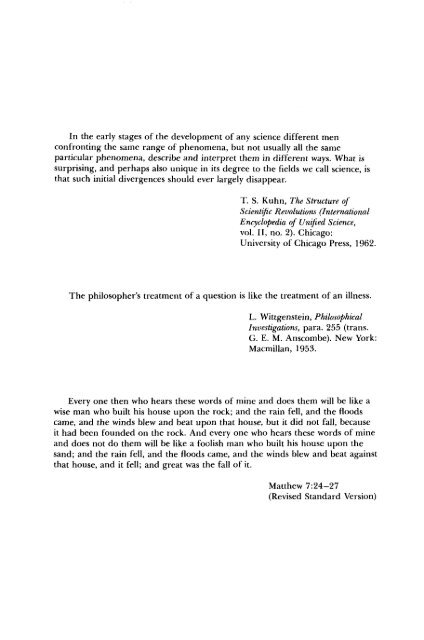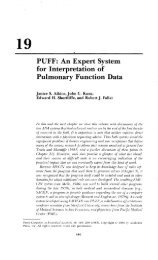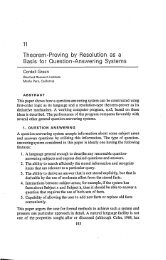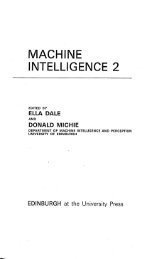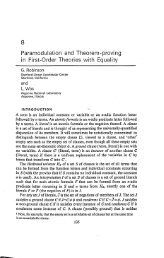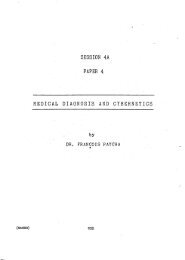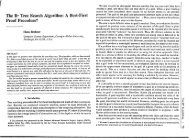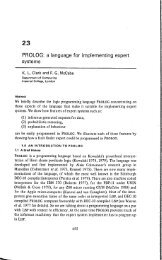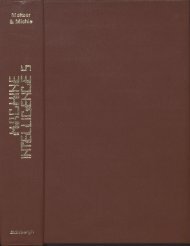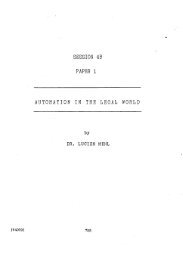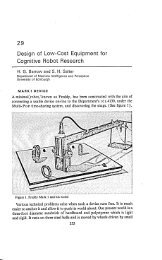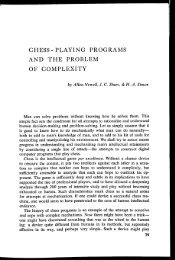Rule-Based Expert Systems: The MYCIN Experiments of ... - AITopics
Rule-Based Expert Systems: The MYCIN Experiments of ... - AITopics
Rule-Based Expert Systems: The MYCIN Experiments of ... - AITopics
You also want an ePaper? Increase the reach of your titles
YUMPU automatically turns print PDFs into web optimized ePapers that Google loves.
In the early stages <strong>of</strong> the development <strong>of</strong> any science different men<br />
confronting the same range <strong>of</strong> phenomena, but not usually all the same<br />
particular phenomena, describe and interpret them in different ways. What is<br />
surprising, and perhaps also unique in its degree to the fields we call science, is<br />
that such initial divergences should ever largely disappear.<br />
T. S. Kuhn, <strong>The</strong> Structure <strong>of</strong><br />
Scientific Revolutions (International<br />
Encyclopedia <strong>of</strong> Unified Science,<br />
vol. II, no. 2). Chicago:<br />
University <strong>of</strong> Chicago Press, 1962.<br />
<strong>The</strong> philosopher’s treatment <strong>of</strong> a question is like the treatment <strong>of</strong> an illness.<br />
L. Wittgenstein, Philosophical<br />
Investigations, para. 255 (trans.<br />
G. E. M. Anscombe). New York:<br />
Macmillan, 1953.<br />
Every one then who hears these words <strong>of</strong> mine and does them will be like a<br />
wise man who built his house upon the rock; and the rain fell, and the floods<br />
came, and the winds blew and beat upon that house, but it did not fall, because<br />
it had been founded on the rock. And every one who hears these words <strong>of</strong> mine<br />
and does not do them will be like a foolish man who built his house upon the<br />
sand; and the rain fell, and the floods came, and the winds blew and beat against<br />
that house, and it fell; and great was the fall <strong>of</strong> it.<br />
Matthew 7:24-27<br />
(Revised Standard Version)
Background<br />
PART ONE
1<br />
<strong>The</strong> Context <strong>of</strong> the <strong>MYCIN</strong><br />
<strong>Experiments</strong><br />
Artificial Intelligence (AI) is that branch <strong>of</strong> computer science dealing with<br />
symbolic, nonalgorithmic methods <strong>of</strong> problem solving. Several aspects <strong>of</strong><br />
this statement are important for understanding <strong>MYCIN</strong> and the issues<br />
discussed in this book. First, most uses <strong>of</strong> computers over the last 40 years<br />
have been in numerical or data-processing applications, but most <strong>of</strong> a person’s<br />
knowledge <strong>of</strong> a subject like medicine is not mathematical or quantitative.<br />
It is symbolic knowledge, and it is used in a variety <strong>of</strong> ways in problem<br />
solving. Also, the problem-solving methods themselves are usually not<br />
mathematical or data-processing procedures but qualitative reasoning techniques<br />
that relate items through judgmental rules, or heuristics, as well as<br />
through theoretical laws and definitions. An algorithm is a procedure that<br />
is guaranteed either to find the correct solution to a problem in a finite<br />
time or to tell you there is no solution. For example, an algorithm for<br />
opening a safe with three dials is to set the dials on every combination <strong>of</strong><br />
numbers and try the lock after each one. Heuristic methods, on the other<br />
hand, are not guaranteed to work, but will <strong>of</strong>ten find solutions in much<br />
shorter times than will exhaustive trial and error or other algorithms. For<br />
the example <strong>of</strong> the safe, one heuristic is to listen for tumblers to drop into<br />
place. Few problems in medicine have algorithmic solutions that are both<br />
practical and valid. Physicians are forced to reason about an illness using<br />
judgmental rules and empirical associations along with definitive truths <strong>of</strong><br />
physiology.<br />
<strong>MYCIN</strong> is an expert system (Duda and Shortliffe, 1983). By that<br />
mean that it is an AI program designed (a) to provide expert-level solutions<br />
to complex problems, (b) to be understandable, and (c) to be flexible<br />
enough to accommodate new knowledge easily. Because we have designed<br />
<strong>MYCIN</strong> to provide advice through a consultative dialogue, we sometimes<br />
refer to it as a consultation system.<br />
<strong>The</strong>re are two main parts to an expert system like <strong>MYCIN</strong>: a knowledge<br />
base and an inference mechanism, or engine (Figure l-l). In addition,<br />
there are <strong>of</strong>ten subprograms designed to facilitate interaction with users,
4 <strong>The</strong> Context <strong>of</strong> the <strong>MYCIN</strong> <strong>Experiments</strong><br />
=~<br />
<strong>of</strong> new case<br />
USERIDescription<br />
Advice &<br />
Explanation<br />
User<br />
interface<br />
EXPERT SYSTEM<br />
qp~ Inference Engine<br />
t<br />
qp_~ Knowledge [ Base<br />
FIGURE 1-1 Major parts <strong>of</strong> an expert system. Arrows indicate<br />
information flow.<br />
to help build a knowledge base, to explain a line <strong>of</strong> reasoning, and so forth.<br />
<strong>The</strong> knowledge base is the program’s store <strong>of</strong> facts and associations it<br />
"knows" about a subject area such as medicine. A critical design decision<br />
is how such knowledge is to be represented within the program. <strong>The</strong>re are<br />
many choices, in general. For <strong>MYCIN</strong>, we chose to represent knowledge<br />
mostly as conditional statements, or rules, <strong>of</strong> the following form:<br />
IF: <strong>The</strong>re is evidence that A and B are true,<br />
THEN: Conclude there is evidence that C is true.<br />
This form is <strong>of</strong>ten abbreviated to one <strong>of</strong> the following:<br />
If A and B, then C<br />
A& B--*C<br />
We refer to the antecedent <strong>of</strong> a rule as the premise or left-hand side (LHS)<br />
and to the consequent as the action or right-hand side (RHS).<br />
<strong>The</strong> inference mechanism can take many forms. We <strong>of</strong>ten speak <strong>of</strong><br />
the control structure or control <strong>of</strong> inference to reflect the [’act that there<br />
are different controlling strategies for the system. For example, a set <strong>of</strong><br />
rules may be chained together, as in this example:<br />
If A, then B (<strong>Rule</strong> 1)<br />
If B, then C (<strong>Rule</strong> 2)<br />
A<br />
.’.C<br />
(Data)<br />
(Conclusion)
<strong>The</strong> Context <strong>of</strong> the <strong>MYCIN</strong> <strong>Experiments</strong> 5<br />
This is sometimes called forward chaining, or data-directed inference, because<br />
the data that are known (in this case A) drive the inferences from<br />
left to right in rules, with rules chaining together to deduce a conclusion<br />
(C).<br />
<strong>MYCIN</strong> primarily uses backward chaining, or a goal-directed control<br />
strategy. <strong>The</strong> deductive validity <strong>of</strong> the argument is established in the same<br />
way, but the system’s behavior is quite different. In goal-directed reasoning<br />
a system starts with a statement <strong>of</strong> the goal to achieve and works "backward"<br />
through inference rules, i.e., from right to left, to find the data that<br />
establish that goal, for example:<br />
Find out about C (Goal)<br />
If B, then C (<strong>Rule</strong> 1)<br />
If A, then B (<strong>Rule</strong> 2)<br />
.’.If A, then C<br />
(Implicit rule)<br />
Question: Is A true<br />
(Data)<br />
Since there are many rule chains and many pieces <strong>of</strong> data about which the<br />
system needs to inquire, we sometimes say that <strong>MYCIN</strong> is an evidencegathering<br />
program.<br />
<strong>The</strong> whole expert system is used to perform a task, in <strong>MYCIN</strong>’s case<br />
to provide diagnostic and therapeutic advice about a patient with an infection<br />
as described in Section 1.2. We sometimes refer to the whole system,<br />
shown in Figure 1-1, as the performance system to contrast it with other<br />
subsystems not so directly related to giving advice. <strong>MYCIN</strong> contains an<br />
explanation subsystem, for example, which explains the reasoning <strong>of</strong> the<br />
performance system (see Part Six).<br />
Several <strong>of</strong> the chapters in this book deal with the problems <strong>of</strong> constructing<br />
a performance system in the first place. We have experimented<br />
with different kinds <strong>of</strong> s<strong>of</strong>tware tools that aid in the construction <strong>of</strong> a new<br />
system, mostly by helping with the formulation and understanding <strong>of</strong> a<br />
new knowledge base. We refer to the process <strong>of</strong> mapping an expert’s knowledge<br />
into a program’s knowledge base as knowledge engineering. 1 <strong>The</strong> intended<br />
users <strong>of</strong> these kinds <strong>of</strong> tools are either (a) the so-called knowledge<br />
engineers who help an expert formulate and represent domain-specific<br />
knowledge for the performance system or (b) the experts themselves. AI-<br />
1<strong>The</strong> term knowledgengineering was, to the best <strong>of</strong> our knowledge, coined by Edward Feigenbaum<br />
after Donald Michie’s phrase epistemological engineering. Like the phrases expert system<br />
and knowledge-based system, however, it did not come into general use until about 1975. For<br />
more discussion <strong>of</strong> expert systems, see Buchanan and Duda (1983).
6 <strong>The</strong> Context <strong>of</strong> the <strong>MYCIN</strong> <strong>Experiments</strong><br />
though either group might also run the performance system to test it,<br />
neither overlaps with the intended routine users <strong>of</strong> the performance system.<br />
Our model is that engineers help experts build a system that others<br />
later use to get advice. Elaborating on the previous diagrams, we show this<br />
model in Figure 1-2.<br />
Choice <strong>of</strong> Programming Language<br />
LISP has been the programming language <strong>of</strong> choice for AI programs for<br />
nearly two decades (McCarthy et al., 1962). It is a symbol manipulation<br />
language <strong>of</strong> extreme flexibility based on a small number <strong>of</strong> simple constructs.<br />
2 We are <strong>of</strong>ten asked why we chose LISP for work on <strong>MYCIN</strong>, so<br />
a brief answer is included here. Above all, we needed a language and<br />
programming environment that would allow rapid modification and testing<br />
and in which it was easy and natural to separate medical rules in the<br />
knowledge base from the inference procedures that use the rules. LISP is<br />
an interpretive language and thus does not require that programs be recompiled<br />
after they have been modified in order to test them. Moreover,<br />
LISP removes the distinction between programs and data and thus allows<br />
us to use rules as parts <strong>of</strong> the program and to examine and edit them as data<br />
structures. <strong>The</strong> editing and debugging facilities <strong>of</strong> Interlisp also aided our<br />
research greatly.<br />
Successful AI programs have been written in many languages. Until<br />
recently LISP was considered to be too slow and too large for important<br />
applications. Thus there were reasons to consider other languages. But for<br />
a research effort, such as this one, we were much more concerned with<br />
saving days during program development than with saving seconds at run<br />
time. We needed the flexibility that LISP <strong>of</strong>fered. When Interlisp became<br />
available, we began using it because it promised still more convenience<br />
than other versions. Now that additional tools, such as E<strong>MYCIN</strong>, have been<br />
built on top <strong>of</strong> Interlisp, more savings can be realized by building new<br />
systems using those tools (when appropriate) than by building from the<br />
base-level LISP system. At the time we began work on <strong>MYCIN</strong>, however,<br />
we had no choice.<br />
1.1<br />
Historical Perspective on <strong>MYCIN</strong><br />
As best as we can tell, production rules were brought into artificial intelligence<br />
(AI) by Allen Newell, who had seen their power and simplicity<br />
demonstrated in Robert Floyd’s work on formal languages and compilers<br />
’)See Winston and Horn ( 1981), Charniak et al. (1980), and Allen (1978) for more information<br />
about the language itself.
~t<br />
X<br />
LU:<br />
I’-<br />
UA<br />
O.<br />
e-<br />
0<br />
v<br />
J~ o
8 <strong>The</strong> Context <strong>of</strong> the <strong>MYCIN</strong> <strong>Experiments</strong><br />
(Floyd, 1961) at Carnegie-Mellon University. Newell saw ih production<br />
systems an elegant formalism for psychological modeling, a theme still<br />
pursued at Carnegie-Mellon University and elsewhere. Through conversations<br />
between Newell and himself at Stanford in the 1960s (see Newell,<br />
1966), Edward Feigenbaum began advocating the use <strong>of</strong> production rules<br />
to encode domain-specific knowledge in DENDRAL. Don Waterman<br />
picked up on the suggestion, but decided to work with rules and heuristics<br />
<strong>of</strong> the game <strong>of</strong> poker (Waterman, 1970) rather than <strong>of</strong> mass spectrometry.<br />
His success, and Feigenbaum’s continued advocacy, led to recoding much<br />
<strong>of</strong> DENDRAUs knowledge into rules (Lindsay et al., 1980).<br />
<strong>The</strong> DENDRAL program was the first AI program to emphasize the<br />
power <strong>of</strong> specialized knowledge over generalized problem-solving methods<br />
(see Feigenbaum et al., 1971). It was started in the mid-1960s by Joshua<br />
Lederberg and Feigenbaum as an investigation <strong>of</strong> the use <strong>of</strong> AI techniques<br />
for hypothesis formation. It constructed explanations <strong>of</strong> empirical data in<br />
organic chemistry, specifically, explanations <strong>of</strong> analytic data about the molecular<br />
structure <strong>of</strong> an unknown organic chemical compound. "~ By the mid-<br />
1970s there were several large programs, collectively called DENDRAL,<br />
which interacted to help organic chemists elucidate molecular structures.<br />
<strong>The</strong> programs are knowledge-intensive; that is, they require very specialized<br />
knowledge <strong>of</strong> chemistry in order to produce plausible explanations <strong>of</strong><br />
the data. Thus a major concern in research on DENDRAL was how to<br />
represent specialized knowledge <strong>of</strong> a domain like chemistry so that a computer<br />
program could use it for complex problem solving.<br />
<strong>MYCIN</strong> was an outgrowth <strong>of</strong> DENDRAL in the sense that many <strong>of</strong><br />
the lessons learned in the construction <strong>of</strong> DENDRAL were used in the<br />
design and implementation <strong>of</strong> <strong>MYCIN</strong>. Foremost among these was the<br />
newfound power <strong>of</strong> production rules, as discussed in Chapter 2. <strong>The</strong> senior<br />
members <strong>of</strong> the DENDRAL team, Lederberg and Feigenhaum, had convinced<br />
themselves and Bruce Buchanan that the AI ideas that made DEN-<br />
DRAL work could be applied to a problem <strong>of</strong> medical import. At about<br />
that time, Edward Shortliff’e had just discovered AI as a medical student<br />
enrolled in a Computer Science Department course entitled "Models <strong>of</strong><br />
Thought Processes," taught at the time by Jerome Feldman. Also, Stanley<br />
Cohen, then Chief <strong>of</strong> Clinical Pharmacology at the Stanford University<br />
Medical School, had been working on a medical computing project, the<br />
MEDIPHOR drug interaction warning system (Cohen et al., 1974). He had<br />
sought Buchanan’s involvement and had also just accepted Shortliffe as a<br />
research assistant on the project. In addition, the late George Forsythe,<br />
then Chairman <strong>of</strong> the Computer Science Department, was strongly supportive<br />
<strong>of</strong> this kind <strong>of</strong> interdisciplinary research project and encouraged<br />
3Even more specifically, the data abom the unknown compound were data from a mass<br />
spectrometer, an instrument that bombards a small sample uf a compound with high-energy<br />
electrons and produces data on the resulting fragments.
Historical Perspective on <strong>MYCIN</strong> 9<br />
Shortliffe in his efforts to obtain formal training in the field. Thus the<br />
scene was set for a collaborative effort involving Cohen, Buchanan, and<br />
Shortliffe--an effort that ultimately grew into Shortliffe’s dissertation.<br />
After six months <strong>of</strong> collaborative effort on MEDIPHOR, our discussions<br />
began to focus on a computer program that would monitor physicians’<br />
prescriptions for antibiotics and generate warnings on inappropriate<br />
prescriptions in the same way that MEDIPHOR produced warnings regarding<br />
potential drug-drug interactions. Such a program would have<br />
needed to access data bases on three Stanford computers: the pharmacy,<br />
clinical laboratory, and bacteriology systems. It would also have required<br />
considerable knowledge about the general and specific conditions that<br />
make one antibiotic, or combination <strong>of</strong> antibiotics, a better choice than<br />
another. Cohen interested Thomas Merigan, Chief <strong>of</strong> the Infectious Disease<br />
Division at Stanford, in lending both his expertise and that <strong>of</strong> Stanton<br />
Axline, a physician in his division. In discussing this new kind <strong>of</strong> monitoring<br />
system, however, we quickly realized that it would require much more<br />
medical knowledge than had been the case for MEDIPHOR. Before a<br />
system could monitor for inappropriate therapeutic decisions, it would<br />
need to be an "expert" in the field <strong>of</strong> antimicrobial selection. Thus, with<br />
minor modifications for direct data entry from a terminal rather than from<br />
patient data bases, a monitoring system could be modified to provide consultations<br />
to physicians. Another appeal <strong>of</strong> focusing on an interactive system<br />
was that it provided us with a short-term means to avoid the difficulty<br />
<strong>of</strong> linking three computers together to provide data to a monitoring system.<br />
Thus our concept <strong>of</strong> a computer-based consultant was born, and we<br />
began to model <strong>MYCIN</strong> after infectious disease consultants. This model<br />
also conformed with Cohen’s strong belief that a computer-based aid for<br />
medical decision making should suggest therapy as well as diagnosis.<br />
Shortliffe synthesized medical knowledge from Cohen and Axline and<br />
AI ideas from Buchanan and Cordell Green. Green suggested using Interlisp<br />
(then known as BBN-LISP), which was running at SRI International<br />
(then Stanford Research Institute) but was not yet available at the university.<br />
Conversations with him also led to the idea <strong>of</strong> using Carbonell’s program,<br />
SCHOLAR (Carbonell, 1970a), as a model for <strong>MYCIN</strong>. SCHOLAR<br />
represented facts about the geography <strong>of</strong> South America in a large semantic<br />
network and answered questions by making inferences over the<br />
net. However, this model was not well enough developed for us to see how<br />
a long dialogue with a physician could be focused on one lin e <strong>of</strong> reasoning<br />
at a time. We also found it difficult to construct semantic networks for the<br />
ill-structured knowledge <strong>of</strong> infectious disease. We turned instead to a rulebased<br />
approach that Cohen and Axline found easier to understand, particularly<br />
because chained rules led to lines <strong>of</strong> reasoning that they could<br />
understand and critique.<br />
One important reason for the success <strong>of</strong> our early efforts was Shortliffe’s<br />
ability to provide quickly a working prototype program that would<br />
show Cohen and Axline the consequences <strong>of</strong> the rules they had stated at
10 <strong>The</strong> Context <strong>of</strong> the <strong>MYCIN</strong> <strong>Experiments</strong><br />
each meeting. <strong>The</strong> modularity <strong>of</strong> the rules was an important benefit in<br />
providing rapid feedback on changes. Focusing early on a working program<br />
not only kept the experts interested but also allowed us to design the<br />
emerging program in response to real problems instead <strong>of</strong> trying to imagine<br />
the shape <strong>of</strong> the problems entirely in advance <strong>of</strong> their manifestations<br />
in context.<br />
Green recommended hiring Carli Scott as our first full-time employee,<br />
and the <strong>MYCIN</strong> research began to take shape as a coordinated project.<br />
Axline subsequently enlisted help from infectious disease fellows to complement<br />
the expertise <strong>of</strong>" Cohen’s clinical pharmacology fellow. Graduate<br />
students from the Computer Science Department were also attracted to<br />
the work, partly because <strong>of</strong>" its social relevance and partly because it was<br />
new and exciting. Randall Davis, for example, had been working on vision<br />
understanding at the Stanford AI Lab and had been accepted for medical<br />
school when he heard about <strong>MYCIN</strong> and decided to invest his research<br />
talents with us.<br />
In our first grant application (October, 1973), we described the goals<br />
<strong>of</strong> the project.<br />
For the past year and a half the Divisions <strong>of</strong> Clinical Pharmacology and<br />
Infectious Disease plus members <strong>of</strong> the Department <strong>of</strong> Computer Science<br />
have collaborated on initial development <strong>of</strong> a computer-based system (termed<br />
<strong>MYCIN</strong>) that will be capable <strong>of</strong> using both clinical data and judgmental decisions<br />
regarding infectious disease therapy. <strong>The</strong> proposed research involves<br />
development and acceptable implementation <strong>of</strong> the following:<br />
A. CONSULTATION PROGRAM. <strong>The</strong> central component <strong>of</strong> the MY-<br />
CIN system is an interactive computer program to provide physicians with<br />
consultative advice regarding an appropriate choice <strong>of</strong> antimicrobial therapy<br />
as determined from data available from the microbiology and clinical chemistry<br />
laboratories and from direct clinical observations entered by the physician<br />
in response to computer-generated questions;<br />
B. INTERACTIVE EXPLANATION CAPABILITIES. Another important<br />
component <strong>of</strong> the system permits the consultation program to explain<br />
its knowledge <strong>of</strong> infectious disease therapy and to.justify specific therapeutic<br />
recommendations;<br />
C. COMPUTER ACQUISITION OF JUDGMENTAL KNOWLEDGE.<br />
<strong>The</strong> third aspect <strong>of</strong> this work seeks to permit experts in the field <strong>of</strong> infectious<br />
disease therapy to teach the <strong>MYCIN</strong> system the therapeutic decision rules<br />
that they find useful in their clinical practice.<br />
<strong>The</strong> submission <strong>of</strong>" our initial grant application encouraged us to choose a<br />
name for the project on which we had already been working for two years.<br />
After [’ailing to find a suitable acronym, we selected the name <strong>MYCIN</strong> at<br />
Axline’s suggestion. This name is simply the common suffix associated with<br />
many antimicrobial agents.<br />
Although we were aiming at a program that would help physicians,<br />
we also realized that there were many computer science problems with
Historical Perspective on <strong>MYCIN</strong> 11<br />
1960’S<br />
J<br />
1970’S<br />
I I<br />
(QA) (Inference)<br />
I<br />
(Evaluation)<br />
CONGEN<br />
¯ Meta-DENDRAL<br />
SU/X<br />
1980’S<br />
BAOBAB<br />
I GUIDON I<br />
1<br />
NEO<strong>MYCIN</strong><br />
ONCOCIN<br />
I TEIRESIASI~<br />
"’FFI I I<br />
I SACONI I<br />
’<br />
:l I CENTAUR<br />
E<strong>MYCIN</strong> I<br />
~, GRAVIDA<br />
WHEEZE CLOT<br />
DART<br />
J<br />
FIGURE 1-3 HPP programs relating to <strong>MYCIN</strong>. (Program<br />
names in boxes were Ph.D. dissertation research programs.)<br />
which we had to grapple. No other AI program, including DENDRAL,<br />
had been built using so much domain-specific knowledge so clearly separated<br />
from the inference procedures.<br />
A schematic review <strong>of</strong> the history <strong>of</strong> the work on <strong>MYCIN</strong> and related<br />
projects is shown in Figure 1-3. <strong>MYCIN</strong> was one <strong>of</strong> several projects in the<br />
Stanford Heuristic Programming Project (HPP); others were DENDRAL,<br />
CONGEN, Meta-DENDRAL, and SU/X. 4 <strong>The</strong>re was much interaction<br />
tLater renamed IqASI)/SIAP (Nii and Feigenbaum, 1978; Nii et al., 1982).
12 <strong>The</strong> Context <strong>of</strong> the <strong>MYCIN</strong> <strong>Experiments</strong><br />
among the individuals working in HPP that is not shown in this simplified<br />
diagram, <strong>of</strong> course. Within the <strong>MYCIN</strong> project individuals were working<br />
on several nearly separable subprojects, some <strong>of</strong> which are shown: Question<br />
Answering (QA), Inference (including certainty factors, or CF’s,<br />
the therapy recommendation code), Explanation, Evaluation, and Knowledge<br />
Acquisition. <strong>The</strong>se subprojects formed the basis <strong>of</strong> several <strong>of</strong> the<br />
experiments reported in this volume. All were well-fbcused projects since<br />
we were undertaking them partly to improve the knowledge base and the<br />
performance <strong>of</strong> <strong>MYCIN</strong>. Figure 1-3 shows roughly the chronology <strong>of</strong><br />
work; however, in the organization <strong>of</strong> this book chronology is not emphasized.<br />
Ancient History<br />
Jaynes (1976) refers to a collection <strong>of</strong> 20,000-30,000 Babylonian tablets,<br />
about 20% <strong>of</strong> which contain sets <strong>of</strong> production rules ("omens") for governing<br />
everyday affairs. 5 <strong>The</strong>se were already written and catalogued by<br />
about 650 B.c. He describes the form <strong>of</strong> each entry as "an if-clause or<br />
protasis followed by a then-clause or apodosis." For example,<br />
"If a horse enters a man’s house and bites either an ass or a man,<br />
the owner <strong>of</strong> the house will die and his household will be scattered."<br />
"If a man unwittingly treads on a lizard and kills it,<br />
he will prevail over his adversary."<br />
Included in these are medical rules, correlating symptoms with prognoses.<br />
According to one <strong>of</strong> Jaynes’ sources (Wilson, 1956; 1962), these<br />
tablets <strong>of</strong> scientific teachings were catalogued by subject matter around 700<br />
B.C. Among the left-hand sides quoted from the medical tablets are the<br />
following (Wilson, 1956):<br />
"If, after a day’s illness, he begins to suffer from headache ..."<br />
"If, at the onset <strong>of</strong> his illness, he had prickly heat..."<br />
"If he is hot (in one place) and cold (in another) .<br />
"If the affected area is clammy with sweat..."<br />
Each clause is catalogued as appearing in 60-150 entries on the tablets.<br />
One right-hand side for the medical rules cited by Wilson is the following:<br />
"... he will die suddenly."<br />
5We are indebted to James Bennett for pointing out this reference.
<strong>MYCIN</strong>’s Task Domain--Antimicrobial Selection 13<br />
Thus we see that large collections <strong>of</strong> simple rules were used for medical<br />
diagnosis long before <strong>MYCIN</strong> and that some thought had been given to<br />
the 6 organization <strong>of</strong> the knowledge base.<br />
1.2<br />
<strong>MYCIN</strong>’s Task DomainmAntimicrobial<br />
Selection<br />
Because a basic understanding <strong>of</strong> <strong>MYCIN</strong>’s task domain is important for<br />
understanding much <strong>of</strong> what follows, we include here a brief description<br />
<strong>of</strong> 7 infectious disease diagnosis and therapy.<br />
1.2.1 <strong>The</strong> Nature <strong>of</strong> the Decision Problem<br />
An antimicrobial agent is any drug designed to kill bacteria or to arrest<br />
their growth. Thus the selection <strong>of</strong> antimicrobial therapy refers to the<br />
problem <strong>of</strong>" choosing an agent (or combination <strong>of</strong> agents) for use in treating<br />
a patient with a bacterial infection. <strong>The</strong> terms antimicrobial and antibiotic<br />
are <strong>of</strong>ten used interchangeably, even though the latter actually refers to<br />
any one <strong>of</strong>" a number <strong>of</strong> drugs that are isolated as naturally occurring<br />
products <strong>of</strong> bacteria or fungi. Thus the well-known penicillin mold is the<br />
source <strong>of</strong>" an antibiotic, penicillin, that is used as an antimicrobial. Some<br />
antibiotics are too toxic for use in treating infectious diseases but are still<br />
used in research laboratories (e.g., dactinomycin) or in cancer chemotherapy<br />
(e.g., daunomycin). Furthermore, some antimicrobials (such as the sulfonamides)<br />
are synthetic drugs and are therefore not antibiotics. <strong>The</strong>re<br />
are also semisynthetic antibiotics (e.g., methicillin) that are produced<br />
chemical laboratories by manipulating a naturally occurring antibiotic molecule.<br />
In writing about <strong>MYCIN</strong> we have tended not to rely on this formal<br />
distinction between antimicrobial and antibiotic and have used the terms<br />
as though they were synonymous.<br />
Antimicrobial selection would be a trivial problem if there were a single<br />
nontoxic agent effective against all bacteria capable <strong>of</strong> causing human disease.<br />
However, drugs that are highly useful against certain organisms are<br />
<strong>of</strong>ten not the most effective against others. <strong>The</strong> identity (genus) <strong>of</strong> the<br />
organism causing an infection is therefore an important clue for deciding<br />
~i<strong>The</strong> fact that the rules on the tablets were themselves indexed by premise clauses would<br />
suggest that they were used in data-directed fashion. Yet the global organization <strong>of</strong> rules on<br />
tablets was by suk~iect matter, so that medical rules were together, house-building rules together,<br />
and so on. This "big switch" organization <strong>of</strong> the knowledge base is an early instance<br />
<strong>of</strong> using rule groups to focus the attention <strong>of</strong> the problem solver, a pressing problem, especially<br />
ill large, data-directed systemsuch as the Babylonian omens.<br />
7This section is based on a similar discussion by Shortliffe (1974).
14 <strong>The</strong> Context <strong>of</strong> the <strong>MYCIN</strong> <strong>Experiments</strong><br />
what drugs are apt to be beneficial for the patient. Initially, <strong>MYCIN</strong> did<br />
not consider infections caused by viruses or pathogenic fungi, but since<br />
these other kinds <strong>of</strong> organisms are particularly significant as causes <strong>of</strong><br />
meningitis, they were later added when we began to work with that domain.<br />
Selection <strong>of</strong> therapy is a four-part decision process. First, the physician<br />
must decide whether or not the patient has a significant infection requiring<br />
treatment. If there is significant disease, the organism must be identified<br />
or the range <strong>of</strong> possible identities must be inferred. <strong>The</strong> third step is to<br />
select a set <strong>of</strong> drugs that may be appropriate. Finally, the most appropriate<br />
drug or combination <strong>of</strong> drugs must be selected from the list <strong>of</strong> possibilities.<br />
Each step in this decision process is described below.<br />
Is the Infection Significant<br />
<strong>The</strong> human body is normally populated by a wide variety <strong>of</strong> bacteria.<br />
Organisms can invariably be cultured from samples taken from a patient’s<br />
skin, throat, or stool. <strong>The</strong>se normal flora are not associated with disease in<br />
most patients and are, in fact, <strong>of</strong>ten important to the body’s homeostatic<br />
balance. <strong>The</strong> isolation <strong>of</strong> bacteria from a patient is therefore not presumptive<br />
evidence <strong>of</strong> significant infectious disease.<br />
Another complication is the possibility that samples obtained from<br />
normally sterile sites (such as the blood, cerebrospinal fluid, or urinary<br />
tract) will be contaminated with external organisms either during the collection<br />
process itself or in the microbiology laboratory where the cultures<br />
are grown. It is therefore <strong>of</strong>ten wise to obtain several samples and to see<br />
how many contain organisms that may be associated with significant disease.<br />
Because the patient does have a normal bacterial flora and contamination<br />
<strong>of</strong> cultures may occur, determination <strong>of</strong> the significance <strong>of</strong> an infection<br />
is usually based on clinical criteria. Does the patient have a fever<br />
Is he or she coughing up sputum filled with bacteria Does the patient<br />
have skin or blood findings suggestive <strong>of</strong> serious infection Is his or her<br />
chest x-ray normal Does the patient have pain or inflammation <strong>The</strong>se<br />
and similar questions allow the physician to judge the seriousness <strong>of</strong> the<br />
patient’s condition and <strong>of</strong>ten demonstrate why the possibility <strong>of</strong> infection<br />
was considered in the first place.<br />
What Is the Organism’s Identity<br />
<strong>The</strong>re are several laboratory tests that allow an organism to be identified.<br />
<strong>The</strong> physician first obtains a sample from the site <strong>of</strong> suspected infection<br />
(e.g., a blood sample, an aspirate from an abscess, a throat swabbing, or<br />
urine specimen) and sends it to the microbiology laboratory for culture.
<strong>MYCIN</strong>’s Task Domain--Antimicrobial Selection 15<br />
<strong>The</strong>re the technicians first attempt to grow organisms from the sample on<br />
an appropriate nutritional medium. Early evidence <strong>of</strong> growth may allow<br />
them to report the morphological and staining characteristics <strong>of</strong> the organism.<br />
However, complete testing <strong>of</strong> the organism to determine a definite<br />
identity usually requires 24-48 hours or more.<br />
<strong>The</strong> problem with this identification process is that the patient may be<br />
so ill at tile time when the culture is first obtained that the physician cannot<br />
wait two days before beginning antimicrobial therapy. Early data regarding<br />
the organism’s staining characteristics, morphology, growth conformation,<br />
and ability to grow with or without oxygen may therefore become crucially<br />
important for narrowing down the range <strong>of</strong> possible identities. Furthermore,<br />
historical infbrmation about the patient and details regarding his or<br />
her clinical status may provide additional useful clues as to the organism’s<br />
identity.<br />
What Are the Potentially<br />
Useful Drugs<br />
Even once the identity <strong>of</strong> an organism is known with certainty, its range<br />
<strong>of</strong> antimicrobial sensitivities may be unknown. For example, although a<br />
Pseudomonas is usually sensitive to gentamicin, an increasing number <strong>of</strong><br />
gentamicin-resistant Pseudomonae are being isolated. For this reason the<br />
microbiology technicians will <strong>of</strong>ten run in vitro sensitivity tests on an organism<br />
they are growing, exposing the bacterium to several commonly<br />
used antimicrobial agents. This sensitivity information is reported to the<br />
physician so that he or she will know those drugs that are likely to be<br />
effective in vivo (i.e., in the patient).<br />
Sensitivity data do not become available until one or two days after<br />
the culture is obtained, however. <strong>The</strong> physician must therefore <strong>of</strong>ten select<br />
a drug on the basis <strong>of</strong> the list <strong>of</strong> possible identities plus the antimicrobial<br />
agents that are statistically likely to be effective against each <strong>of</strong> the identities.<br />
<strong>The</strong>se statistical data are available from many hospital laboratories<br />
(e.g., 82% <strong>of</strong> E. coli isolated at Stanford Hospital are sensitive in vitro to<br />
gentamicin), although, in practice, physicians seldom use the probabilistic<br />
information except in a rather intuitive sense (e.g., "Most <strong>of</strong> the E. coli<br />
infections I have treated recently have responded to gentamicin.").<br />
Which Drug Is Best for This Patient<br />
Once a list <strong>of</strong> drugs that may be useful has been considered, the best<br />
regimen is selected on the basis <strong>of</strong> a variety <strong>of</strong> factors. <strong>The</strong>se include the<br />
likelihood that the drug will be effective against the organism, as well as a<br />
number <strong>of</strong> clinical considerations. For example, it is important to know<br />
whether or not the patient has any drug allergies and whether or not the<br />
drug is contraindicated because <strong>of</strong> age, sex, or kidney status. If the patient
16 <strong>The</strong> Context <strong>of</strong> the <strong>MYCIN</strong> <strong>Experiments</strong><br />
has meningitis or brain involvement, whether or not the drug crosses the<br />
blood-brain barrier is an important question. Since some drugs can be<br />
given only orally, intravenously (IV), or intramuscularly (IM), the desired<br />
route <strong>of</strong> administration may become an important consideration. <strong>The</strong> severity<br />
<strong>of</strong> the patient’s disease may also be important, particularly for those<br />
drugs whose use is restricted on ecological grounds or which are particularly<br />
likely to cause toxic complications. Furthermore, as the patient’s clinical<br />
status varies over time and more definitive information becomes available<br />
from the microbiology laboratory, it may be wise to change the drug<br />
<strong>of</strong> choice or to modify the recommended dosage.<br />
1.2.2 Evidence That Assistance Is Needed<br />
<strong>The</strong> "antimicrobial revolution" began with the introduction <strong>of</strong> the sulfonamides<br />
in the 1930s and penicillin in 1943. <strong>The</strong> beneficial effects that these<br />
and subsequent drugs have had on humanity cannot be overstated. However,<br />
as early as the 1950s it became clear that antibiotics were being misused.<br />
A study <strong>of</strong> <strong>of</strong>fice practice involving 87 general practitioners (Peterson<br />
et al., 1956) revealed that antibiotics were given indiscriminately to all patients<br />
with upper respiratory infections by 67% <strong>of</strong> the physicians, while<br />
only 33% ever tried to separate viral from bacterial etiologies. Despite<br />
attempts to educate physicians regarding this kind <strong>of</strong> inappropriate therapy,<br />
similar data have continued to be reported (Kunin, 1973).<br />
At the time we began work on <strong>MYCIN</strong>, antibiotic misuse was receiving<br />
wide attention (Scheckler and Bennett, 1970; Roberts and Visconti, 1972;<br />
Kunin, 1973; Simmons and Stolley, 1974; Carden, 1974). <strong>The</strong> studies<br />
showed that very few physicians go through the methodical decision process<br />
that was described above. In the outpatient environment antibiotics<br />
are <strong>of</strong>ten prescribed without the physician’s having identified or even cultured<br />
the <strong>of</strong>fending organism (Kunin, 1973). In 1972 the FDA certified<br />
enough (2,400,000 kg) <strong>of</strong> the commonly used antibiotics to treat two illnesses<br />
<strong>of</strong> average duration in every man, woman, and child in the country.<br />
Yet it has been estimated that the average person has an illness requiring<br />
antibiotic treatment no more <strong>of</strong>ten than once every five to ten years (Kunin,<br />
1973). Part <strong>of</strong> the reason for such overprescribing is the patient’s demand<br />
for some kind <strong>of</strong> prescription with every <strong>of</strong>fice visit (Muller, 1972). It<br />
difficult for many physicians to resist such demands; thus improved public<br />
education is one step toward lessening the problem.<br />
However, antibiotic use is widespread among hospitalized patients as<br />
well. Studies have shown that, on any given day, one-third <strong>of</strong> the patients<br />
in a general hospital are receiving at least one systemic antimicrobial agent<br />
(Roberts and Visconti, 1972; Scheckler and Bennett, 1970; Resztak and<br />
Williams, 1972). <strong>The</strong> monetary cost to both patients and hospitals is enormous<br />
(Reimann and D’ambola, 1966; Kunin, 1973). Simmons and Stolley<br />
(1974) have summarized the issues as follows:
<strong>MYCIN</strong>’s Task Domain--Antimicrobial Selection 17<br />
1. Has the wide use <strong>of</strong> antibiotics led to the emergence <strong>of</strong> new resistant<br />
bacterial strains<br />
2. Has the ecology <strong>of</strong> "natural" or "hospital" bacterial flora been shifted<br />
because <strong>of</strong> antibiotic use<br />
3. Have nosocomial (i.e., hospital-acquired) infections changed in incidence<br />
or severity due to antibiotic use<br />
4. What are the trends <strong>of</strong> antibiotic use<br />
5. Are antibiotics properly used in practice<br />
¯ Is there evidence that prophylactic use <strong>of</strong> antibiotics is harmful, and<br />
how common is it<br />
¯ Are antibiotics <strong>of</strong>ten prescribed without prior bacterial culture<br />
¯ When cultures are taken, is the appropriate antibiotic usually prescribed<br />
and correctly used<br />
6. Is the increasingly more frequent use <strong>of</strong> antibiotics presenting the medical<br />
community and the public with a new set <strong>of</strong> hazards that should be<br />
approached by some new administrative or educational measures<br />
Having stated the issues, these authors proceed to cite evidence that indicates<br />
that each <strong>of</strong> these questions has frightening answers--that the effects<br />
<strong>of</strong> antibiotic misuse are so far-reaching that the consequences may<br />
<strong>of</strong>ten be worse than the disease (real or imagined) being treated!<br />
Our principal concern has been with the fifth question: are physicians<br />
rational in their prescribing habits and, if not, why not Roberts and Visconti<br />
examined these issues in 1,035 patients consecutively admitted to a<br />
500-bed community hospital (Roberts and Visconti, 1972). Of 340 patients<br />
receiving systemic antimicrobials, only 35% were treated for infection. <strong>The</strong><br />
rest received either prophylactic therapy (55%) or treatment for symptoms<br />
without verified infection (10%). A panel <strong>of</strong> expert physicians and pharmacists<br />
evaluated these therapeutic decisions, and only 13% were judged<br />
to be rational, while 66% were assessed as clearly irrational. <strong>The</strong> remainder<br />
were said to be questionable.<br />
Of particular interest were the reasons why therapy was judged to be<br />
irrational in those patients for whom some kind <strong>of</strong> antimicrobial therapy<br />
was warranted. This group consisted <strong>of</strong> 112 patients, or 50.2% <strong>of</strong> the 223<br />
patients who were treated irrationally. It is instructive to list the reasons<br />
that were cited, along with the percentages indicating how many <strong>of</strong> the<br />
112 patients were involved:<br />
Antimicrobial contraindicated in patient<br />
Patient allergic<br />
Inappropriate sequence <strong>of</strong> antimicrobials<br />
Inappropriate combination <strong>of</strong> antimicrobials<br />
Inappropriate antimicrobial used to treat condition<br />
Inappropriate dose<br />
7.1%<br />
2.7<br />
26.8<br />
24.1<br />
62.5<br />
18.7
18 <strong>The</strong> Context <strong>of</strong> the <strong>MYCIN</strong> <strong>Experiments</strong><br />
Inappropriate duration <strong>of</strong> therapy 9.8<br />
Inappropriate route 3.6<br />
Culture and sensitivity needed 17.0<br />
Culture and sensitivity indicate wrong antibiotic being used 16.1<br />
<strong>The</strong> percentages add up to more than 100% because a given therapy may<br />
have been judged inappropriate for more than one reason. Thus 62.5%<br />
<strong>of</strong> the 112 patients who required antimicrobial therapy but were treated<br />
irrationally were given a drug that was inappropriate for their clinical condition.<br />
This observation reflects the need for improved therapy selection<br />
tor patients requiring therapy--precisely the decision task that <strong>MYCIN</strong><br />
was designed to assist.<br />
Once a need for improved continuing medical education in antimicrobial<br />
selection was recognized, there were several valid ways to respond.<br />
One was to <strong>of</strong>fer appropriate post-graduate courses for physicians. Another<br />
was to introduce surveillance systems for the monitoring and approval<br />
<strong>of</strong> antibiotic prescriptions within hospitals (Edwards, 1968; Kunin,<br />
1973). In addition, physicians were encouraged to seek consultations with<br />
infectious disease experts when they were uncertain how best to proceed<br />
with the treatment <strong>of</strong> a bacterial infection. Finally, we concluded that an<br />
automated consultation system that could substitute for infectious disease<br />
experts when they are unavailable or inaccessible could provide a valuable<br />
partial solution to the therapy selection problem. <strong>MYCIN</strong> was conceived<br />
and developed in an attempt to fill that need.<br />
1.3<br />
Organization <strong>of</strong> the Book<br />
This volume is organized into twelve parts <strong>of</strong> two to four chapters, each<br />
highlighting a fundamental theme in the development and evolution <strong>of</strong><br />
<strong>MYCIN</strong>. This introductory part closes with a classic review paper that<br />
outlines the production rule methodology.<br />
<strong>The</strong> design and implementation <strong>of</strong> <strong>MYCIN</strong> are discussed in Part Two.<br />
Shortliffe’s thesis was the beginning, but the original system he developed<br />
was modified as required.<br />
In Part Three we focus on the problems <strong>of</strong> building a knowledge base<br />
and on knowledge acquisition in general. TEIRESIAS, the program resulting<br />
from Randy Davis’ dissertation research, is described.<br />
In Part Four we address the problems <strong>of</strong> reasoning under uncertainty.<br />
<strong>The</strong> certainty factor model, one answer to the question <strong>of</strong> how to propagate<br />
uncertainty in an inference mechanism, forms the basis <strong>of</strong> this part.<br />
Part Five discusses the generality <strong>of</strong> the <strong>MYCIN</strong> formalism. <strong>The</strong> EMY-<br />
CIN system, written largely by William van Melle as part <strong>of</strong> his dissertation
Organization <strong>of</strong> the Book 19<br />
work, is a strongly positive answer to the question <strong>of</strong> whether <strong>MYCIN</strong> could<br />
be generalized.<br />
Work on explanation is reviewed in Part Six. Explanation was a major<br />
design requirement from the start, and many persons contributed to MY-<br />
CIN’s explanation capabilities.<br />
In Part Seven we discuss some <strong>of</strong> the experimentation we were doing<br />
with alternative representations. Jan Aikins’ thesis work on CENTAUR<br />
examined the advantages <strong>of</strong> combining frames and production rules. Larry<br />
Fagan’s work on VM examined the augmentations to a production rule<br />
system that are needed to reason effectively with data monitored over time.<br />
As an outgrowth <strong>of</strong> the explanation work, we came to believe that<br />
<strong>MYCIN</strong> had some pedagogical value to students trying to learn about<br />
infectious disease diagnosis and therapy. William Clancey took this idea<br />
one step further in his research on the GUIDON system, described in Part<br />
Eight. GUIDON is an intelligent tutor that we initially believed could tutor<br />
students about the contents <strong>of</strong> any knowledge base for an E<strong>MYCIN</strong> system.<br />
<strong>The</strong>re is now strong evidence that this hypothesis was false because more<br />
knowledge is needed for tutoring than for advising.<br />
In Part Nine we discuss the concept <strong>of</strong> meta-level knowledge, some <strong>of</strong><br />
which we found to be necessary for intelligent tutoring. We first examined<br />
rules <strong>of</strong> strategy and control, called meta-rules, in the context <strong>of</strong> the TEI-<br />
RESIAS program. One working hypothesis was that meta-rules could be<br />
encoded as production rules similar to those at the object level (medical<br />
rules) and that the same inference and explanation routines could work<br />
with them as well.<br />
From the start <strong>of</strong> the project, we had been concerned about performance<br />
evaluation, as described in Part Ten. We undertook three different<br />
evaluation experiments, each simpler and more realistic but somewhat<br />
more limited than the last.<br />
Another primary design consideration was human engineering, the<br />
subject <strong>of</strong> Part Eleven. We knew that a useful system had to be well enough<br />
engineered to make people want to use it; high performance alone was<br />
not sufficient. <strong>The</strong> chapters in this part discuss experiments with both<br />
natural language interfaces and customized hardware and system architectures.<br />
Finally, in Part Twelve, we attempt to summarize the lessons about<br />
rule-based expert systems that we have learned in nearly a decade <strong>of</strong> research<br />
on the programs named in Figure 1-3. We believe that AI is largely<br />
an experimental science in which ideas are tested in working programs.<br />
Although there are many experiments we neglected to perform, we believe<br />
the descriptions <strong>of</strong> several that we did undertake will allow others to build<br />
on our experience and to compare their results with ours.


